
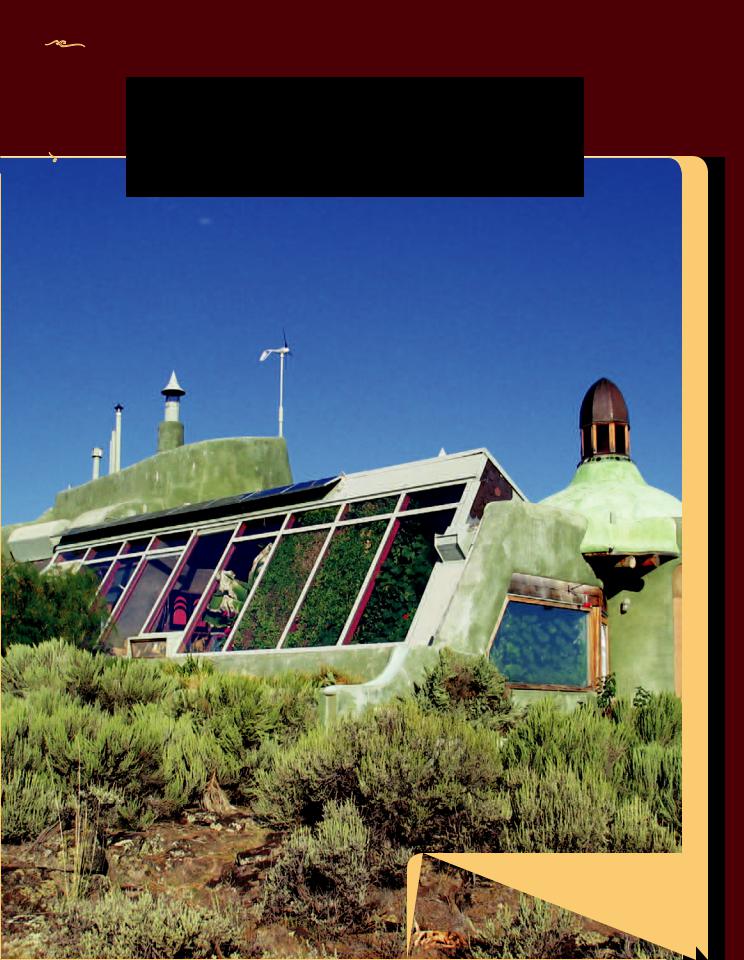
 Earthships
Earthships
This Earthship is constructed from recyclable materials. The house collects the sun’s energy for power. It also collects rainwater, which residents use for washing and flushing toilets.
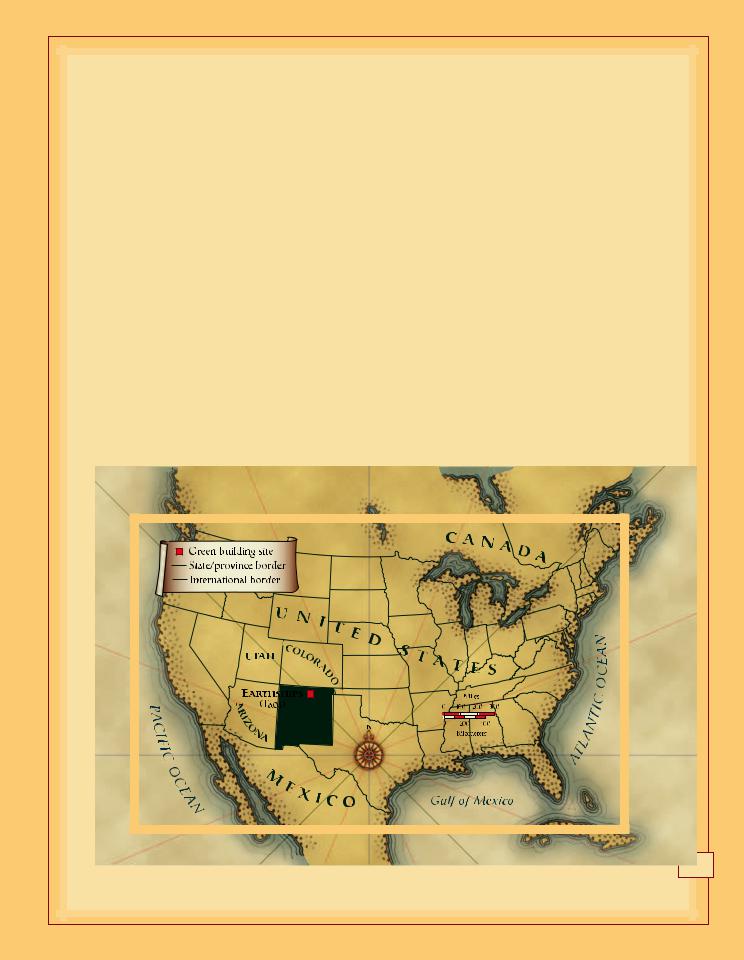
Imagine you were going to take a long
sea voyage. You would have to make sure your ship was
strong enough to withstand storms. You would have to pack
everything you needed for the trip, including freshwater
and food. You might want some of the comforts of home,
including plumbing and electricity. Water pipes and power lines on land would not be able to reach your ship to
provide these comforts. You would have only the sun, the
wind, and the rain, and the items you packed ahead of time.
19
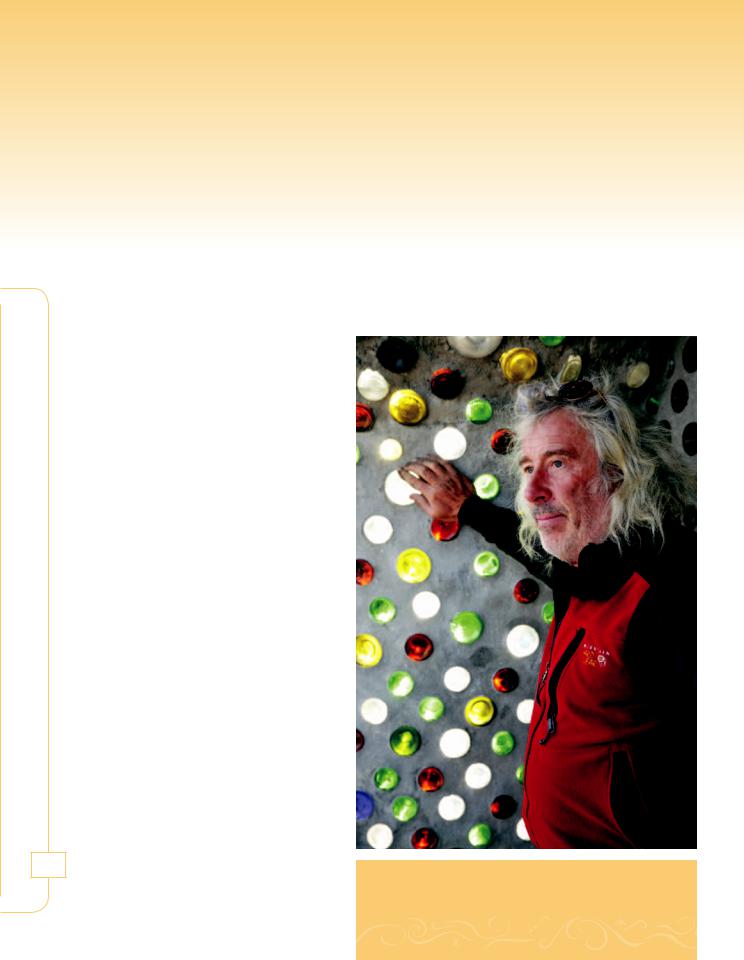
Seven Wonders of Green Building Technology
“The numbers of people continue to grow and the numbers of trees and sources of fuel continue to decrease.”
—Michael Reynolds, Comfort in Any Climate, 2002
New Mexico architect Mike Reynolds believes that homes on land should be like ships headed out for a long trip. The homes should be able to create their own energy and collect their own water. They should be made mostly from recycled materials or from things we already have on hand. And they should be easy to build. Since the
1970s, Reynolds has been building houses with all these qualities. He calls them Earthships.
How Is an
Earthship Different from My Home?
Earthships provide their residents with energy, clean water, comfort, and protection from storms and earthquakes. That probably doesn’t sound too different from the home you live in. The difference is that an Earthship doesn’t rely on power plants, water treatment plants, or
traditional building materials. Instead, an Earthship uses the sun to create its own energy. It harvests (collects) rainfall to get water. And builders make Earthships from natural and recycled materials—dirt, bottles, cans, and even tires.
20
Earthship architect Mike Reynolds leans against a bottlebrick wall in an Earthship modeled after his design.
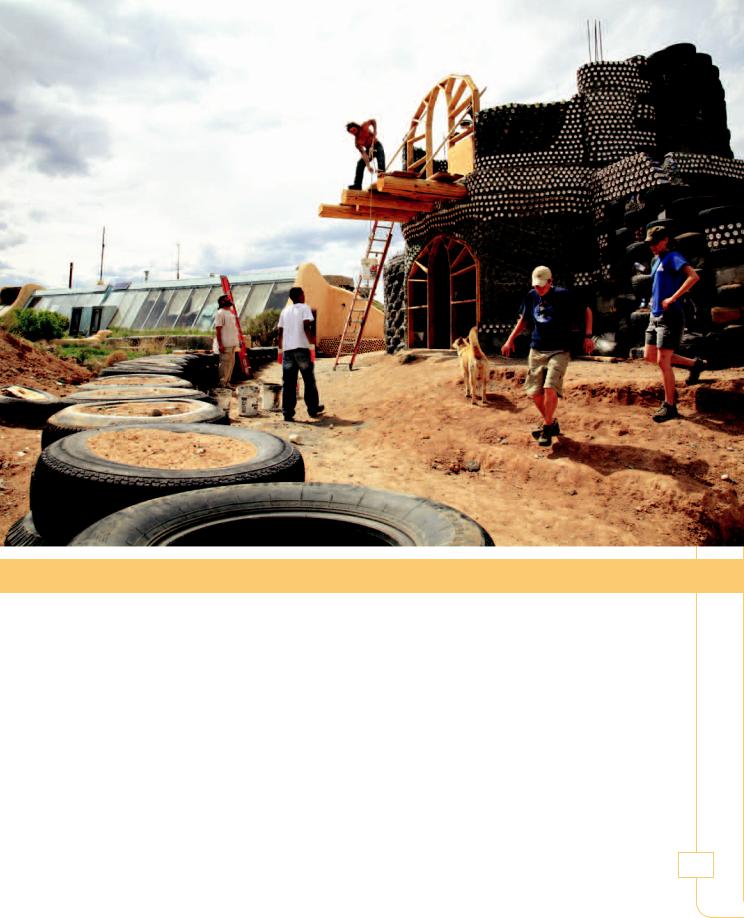
Builders use tires, bottles, cans, and plain old dirt to make Earthships.
Building an Earthship
Building an Earthship is fairly simple. Some homeowners do most of the work themselves. Others hire people to build Earthships for them.
Builders use old car and truck tires to make the walls. They pack dirt inside the tires and stack them on top of one another. Builders then cover the walls with concrete or adobe. Adobe is a kind of clay.
Many people also decorate the walls with “little bricks.” These bricks aren’t made of clay like traditional bricks. Instead, they are empty bottles and cans. These containers reflect light and add color to the walls.
Mike Reynolds has created Earthships with many different floor plans. Some of the designs look similar to traditional homes. But most of them are very unusual.
Earthships
21
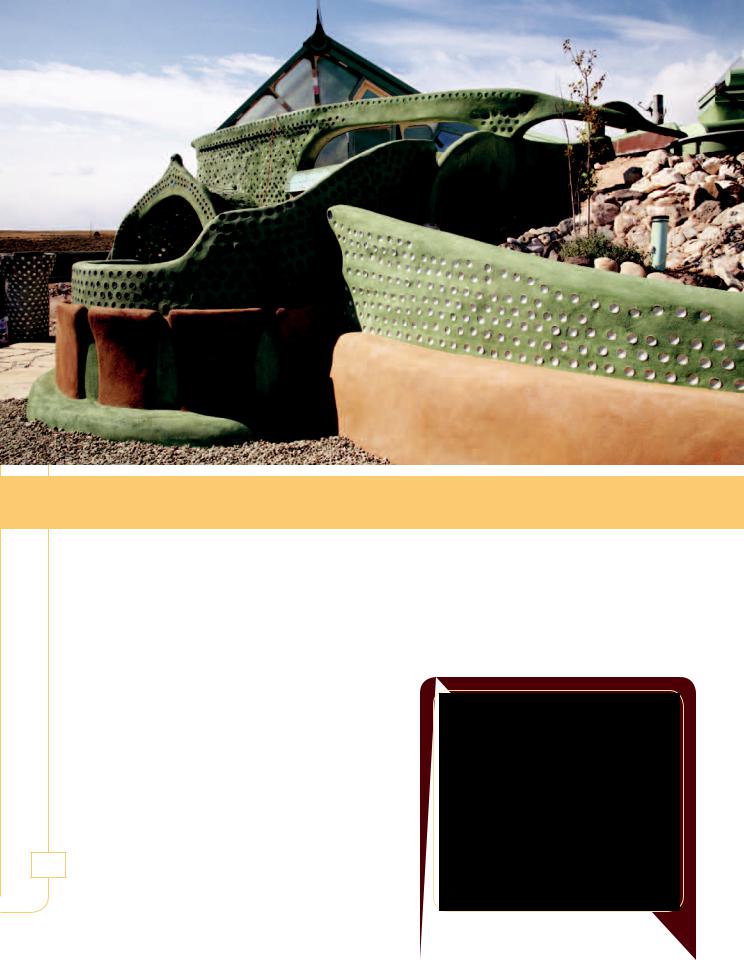
Seven Wonders of Green Building Technology
22
Traditional houses usually have rectangular rooms and straight walls. Builders don’t follow traditional rules when making Earthships.
One design looks like a castle. Another is shaped like a sea creature with a spiral shell.
Most people build Earthships against hillsides. A house built this way looks as if it’s growing out of the side of the hill. The hill serves as a protective wall on one side of the house. It shields the house from cold and wind.
The Many Benefits of Using Old Tires
Using tires to build walls makes good sense. Tires are strong and fireproof. When filled with dirt, tires are also solid and sturdy. And tires are made of rubber, a flexible material. This is a plus in places that have earthquakes.
Hotel
Earthship
Want to see what it’s like to live in an Earthship? Visit http:// www.earthship.net to learn more. People can even rent Earthships for the weekend.
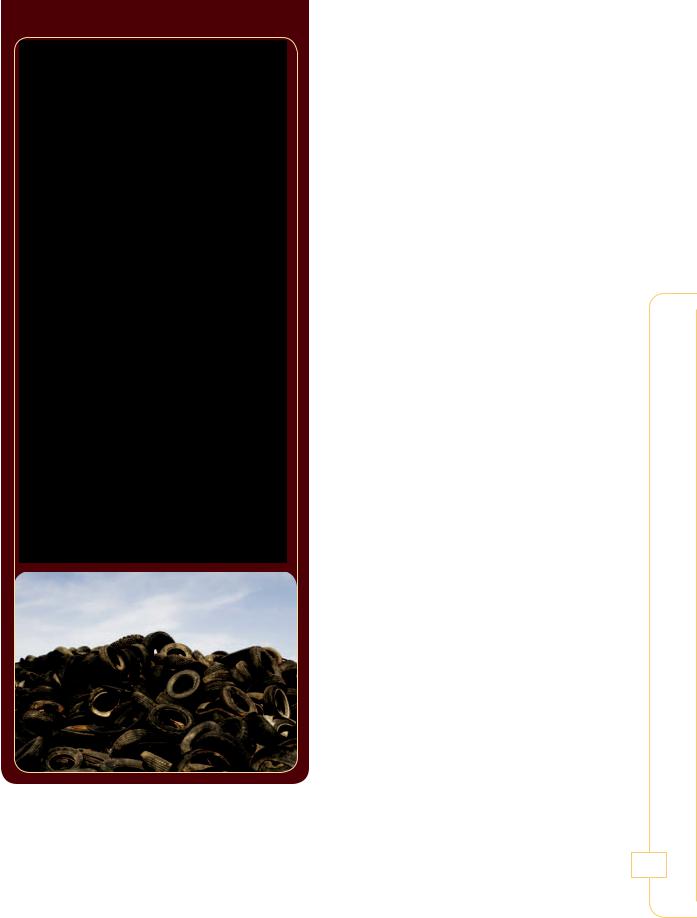
Tires That
Won’t Go
Away
People in the United States get rid of 253 million old tires every year. Companies recycle about half of those tires.They use the rubber to make new products.The other tires pile up in landfills.
Tires do not decompose, or rot, naturally. Heat, cold, and water will eventually break down tires, but this might take thirty to one hundred years. A tire that is protected from the weather might last thirty thousand years. Building Earthships is a good way to recycle old tires so they don’t sit for years and years in landfills.
During earthquakes, ordinary homes can fall down. Their rigid walls can crack and crumble. But the tires inside an Earthship move when the ground moves. So Earthships are not likely to fall apart during a quake.
Using old tires to make Earthships is an example of recycling. The tires have already been used on cars and trucks.
People sometimes dump old worn-out tires in landfills. Sometimes you can see them piled in vacant lots. People who want to build Earthships can usually find old tires nearby. Unlike many traditional building materials, used tires don’t need to be trucked long distances to a building site. This saves gasoline. An added bonus is that used tires are usually free.
Creating
and Storing Energy
An Earthship uses the sun to create electricity. The roof of an Earthship has solar panels. These panels collect the sun’s energy. Devices called photovoltaic cells turn the energy into electricity. Homeowners use this electricity to power all their electrical devices, including lights, computers, and television sets.
An Earthship also uses the sun’s energy for heat. The front of the home is made up mostly of windows. In the Northern
Hemisphere (the northern half of Earth), the windows face south to catch the sun. In the Southern Hemisphere, the windows face north to catch the sun.
Earthships
23
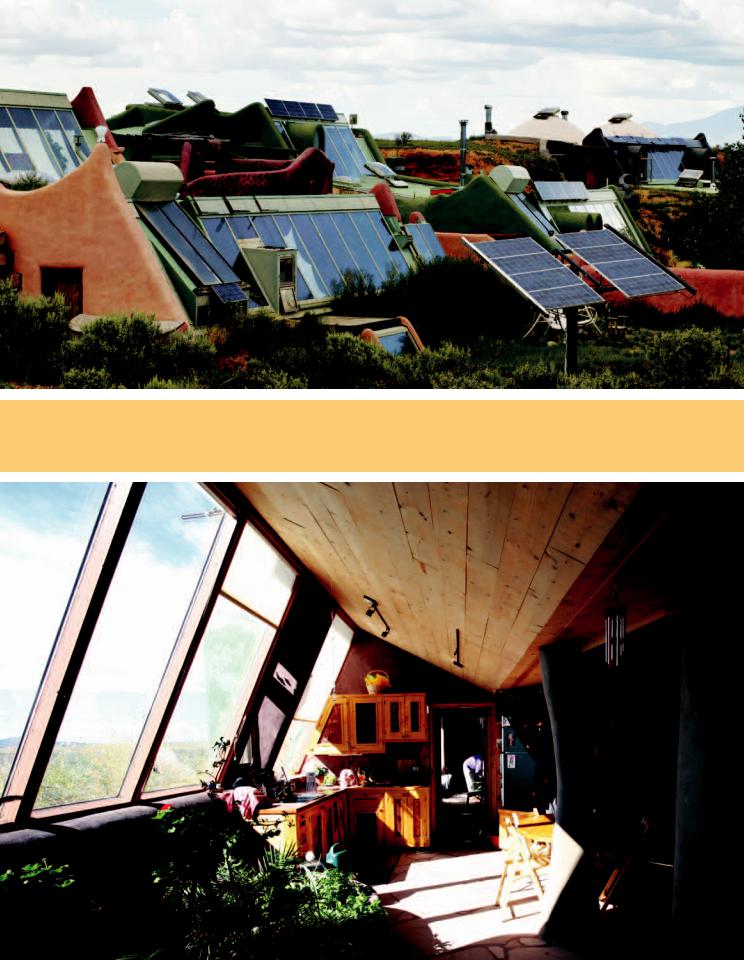
Above: Earthships capture the sun’s energy with solar panels and south-facing windows. Below: Sun pours in through large south-facing windows to light the interior of this Earthship. In summer, residents draw the shades on south-facing windows to help keep the home cool.

On and
Off the Grid
Electricity is a form of energy. This natural force is all around us. Lightning is electrical energy. So is
the shock you sometimes feel when you rub your stocking feet on carpet and then touch metal.That shock is called static electricity.
People have figured out how to create electricity using generators and other devices. From electrical generating stations, electricity travels through power lines and wires to homes and businesses.The system
of power lines and wires that carries electricity is called the electric grid.
When a home or building is “off the grid,” it does not rely on an electric station or power company for its electricity. Earthships are off the grid.They use solar panels and
photovoltaic cells to create electricity. The energy comes from the sun.
When the sun’s rays pour through the windows, the home’s dense walls absorb the heat inside the house.
The thick dirt walls of an Earthship have a property called thermal mass. Thermal mass is the ability to store heat or cold. After an Earthship heats up, the thick walls hold the heat for a long time. They keep the inside of the house warm, even when the sun isn’t shining. In winter it might be a bone-chilling 13°F (−11°C) outside. But inside the Earthship, it will be 64°F (18°C).
In summer, Earthship residents block out the sun’s heat. They close the shades on their front windows. Remember that most Earthships are built against the sides of hills. Earth itself forms the rear wall of an Earthship. Earth has a great amount of thermal mass. It remains cool, even when the weather outside is hot. Earthships rely on this thermal mass for cooling. In summer the temperature outside might be a searing 100°F (38°C). But inside the Earthship, the temperature usually measures a cool 64°F (18°C).
“Building an Earthship costs as much as building an average size home, but without the utility [heat and electric] bills.”
—Bianca Solorzano, CBS News correspondent, 2008
Earthships
25

Harvesting Water
Most of us think of harvesting crops, not water. But people can collect and store water just like crops. When rain falls onto the roof of an Earthship, the water collects in channels. The channels are a lot like gutters on a traditional home. But instead of carrying rainwater to the ground, the channels on an Earthship carry the rainwater into cisterns, or tanks. Pumps and gravity (Earth’s downward pull) take the water through filters. The filters clean the water. They make it safe for drinking, cooking, and bathing.
Any water that’s left over after cooking and washing drains into an interior botanical cell. The cell is a rubber-lined container. It holds gravel and plants. Some people plant fruit and vegetable gardens in their cells. But any plant will do. The plants naturally clean the water. The plant roots and the gravel filter the water and add bacteria. The good bacteria eats away harmful soaps and chemicals. Then residents can use the water again. Water that is too dirty for drinking or bathing goes to a separate drainage system. Residents use it as toilet water.
In general, Earthship residents use water collected from their rooftops four times over. The filtering ensures that residents always have a supply of clean water.
Rainwater travels from the roof into channels and then into cisterns.
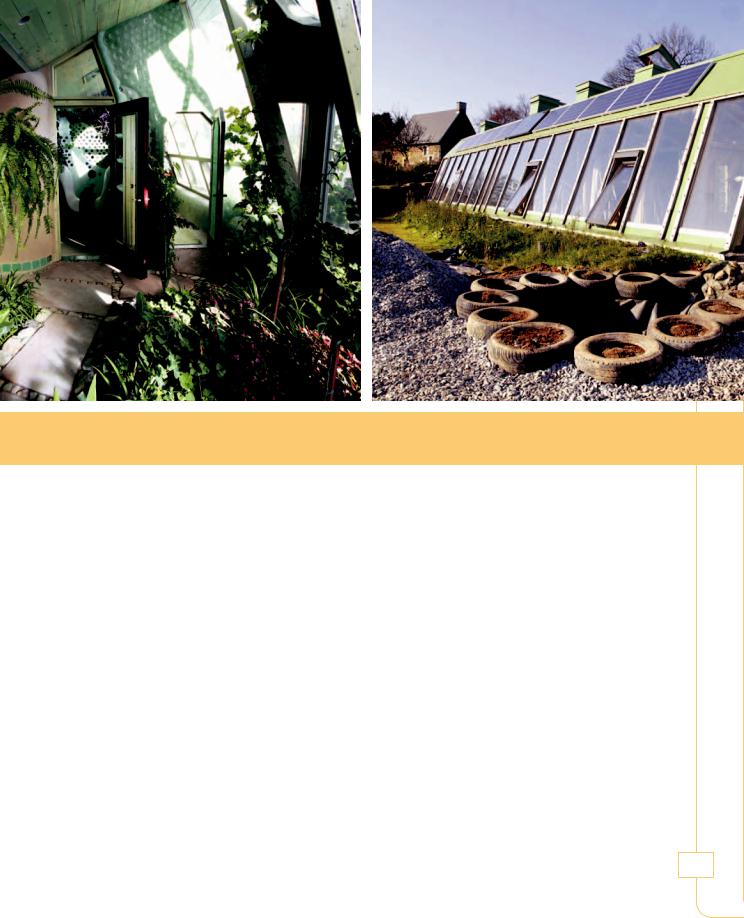
Left: Many people grow lush gardens inside their Earthships. Right: People around the world are discovering the benefits of Earthship living. This Earthship is in France.
Living in an Earthship
People can build Earthships anywhere. They are suited to any climate, whether hot or cold. Most Earthships are in northern New Mexico, where Mike Reynolds started building them in the 1970s. But many other U.S. states have Earthships too. People have also built them in other parts of the world, including Europe, Australia, Central and South America, and Africa.
Why would anyone want to live in an Earthship? People living in ordinary homes use a lot of energy for heating, cooling, and lighting. A family living
in an Earthship has a much smaller carbon footprint. People who live in Earthships say they feel good about working with the environment instead of hurting it.
Earthships
27
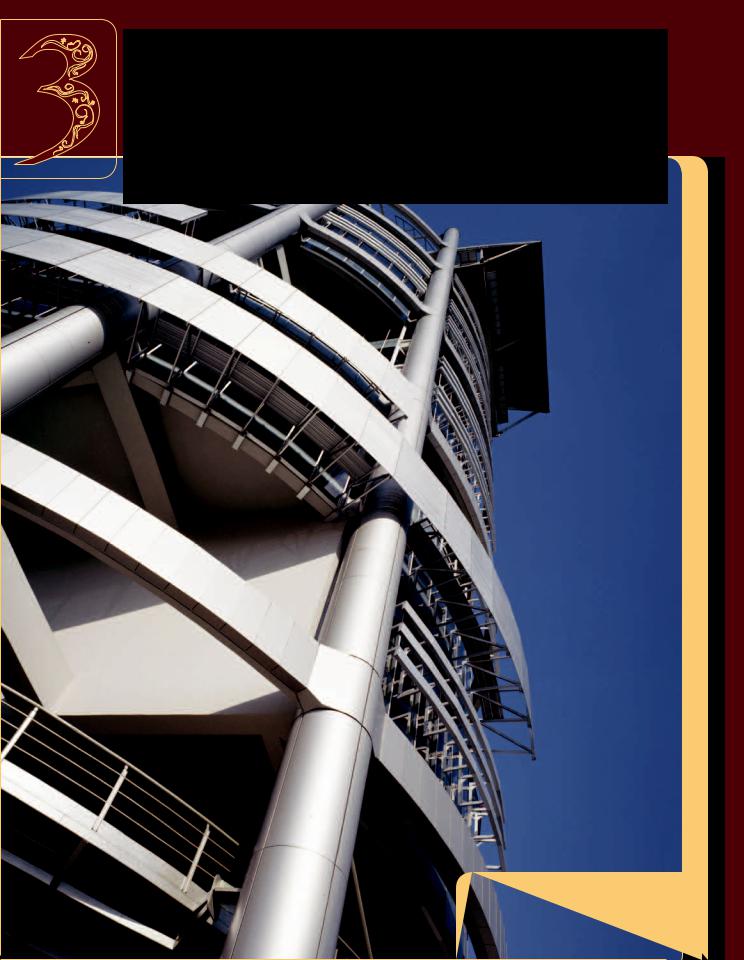
Menara
Mesiniaga
Menara Mesiniaga is not your typical skyscraper. It’s round, and it has lots of balconies and open spaces.
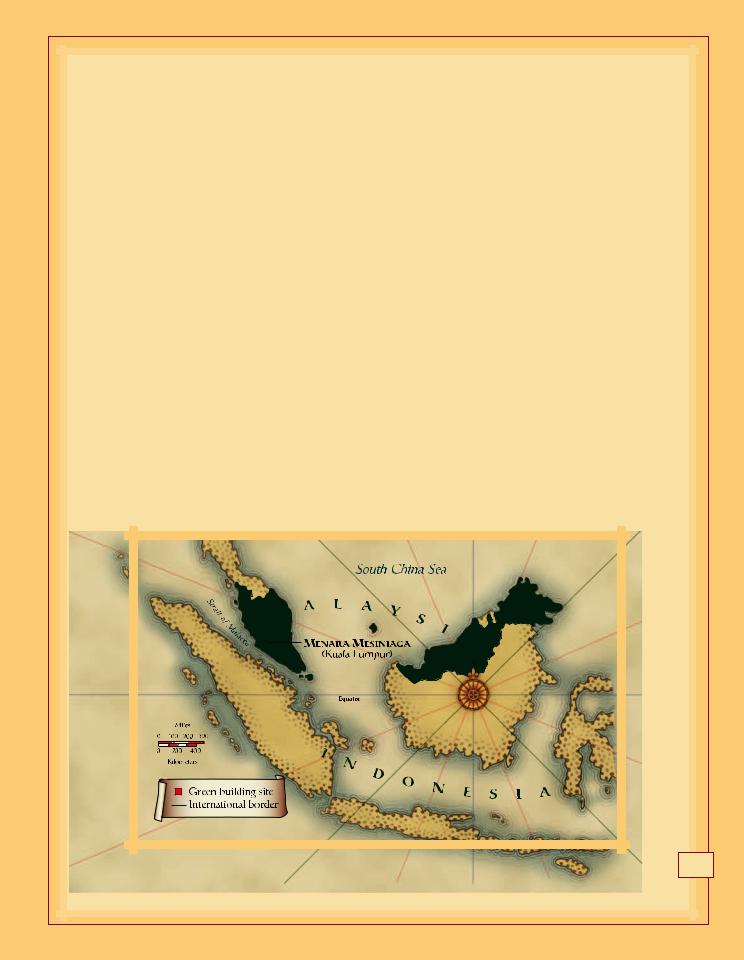
Menara Mesiniaga is the world’s first
green skyscraper. This office building rises about 150 feet (300 m)
in downtown Kuala Lumpur, the capital of Malaysia. Malaysia is
a nation in Southeast Asia. It is near the equator, the imaginary
line that divides Earth into northern and southern halves.
Places near the equator have hot weather all year. They also
receive lots of rain. The region around the equator is called
the tropics. Hot, rainy weather is called tropical weather.
Kuala Lumpur has tropical weather. Temperatures there range from 70 to 90°F (21 to 32°C) year-round. The city is usually sunny in the daytime. The evenings are hot and sometimes have brief thunderstorms.
29

Seven Wonders of Green Building Technology
30
Malaysian architect Ken Yeang designed Menara Mesiniaga in the late 1980s. He wanted to create a skyscraper to fit Kuala Lumpur’s tropical climate, or weather pattern. He also wanted to make a skyscraper that was good for the environment. His building uses plants, the sun, and the wind for lighting and cooling.
Traditional
Skyscrapers
Anyone who has visited New York City or Chicago, Illinois, has seen skyscrapers. These tall buildings provide spaces where many people can work or live. In big cities, land is expensive. People try to get as much usable
space as they can from small plots of land. Skyscrapers take up very little space on the ground. But they can tower high into the sky. Each story, or level, is like another plot of ground.
Many modern skyscrapers look similar. They are tall, boxy towers made of steel, aluminum, concrete, and glass. These materials are strong. They can withstand
fierce winds and cold weather. During winter the concrete in a skyscraper soaks up sunlight.
Architect Ken Yeang designs buildings that work with the environment.
When Was the
First Skyscraper
Built?
The first skyscraper ever built was the Home Insurance Building in Chicago. Builders took two years (from 1884 to 1885) to construct the skyscraper.This building was ten stories and 138 feet (42 meters) tall. It was one of the first buildings with a fireproof metal frame. The city tore it down in 1931 to make room for a new building.
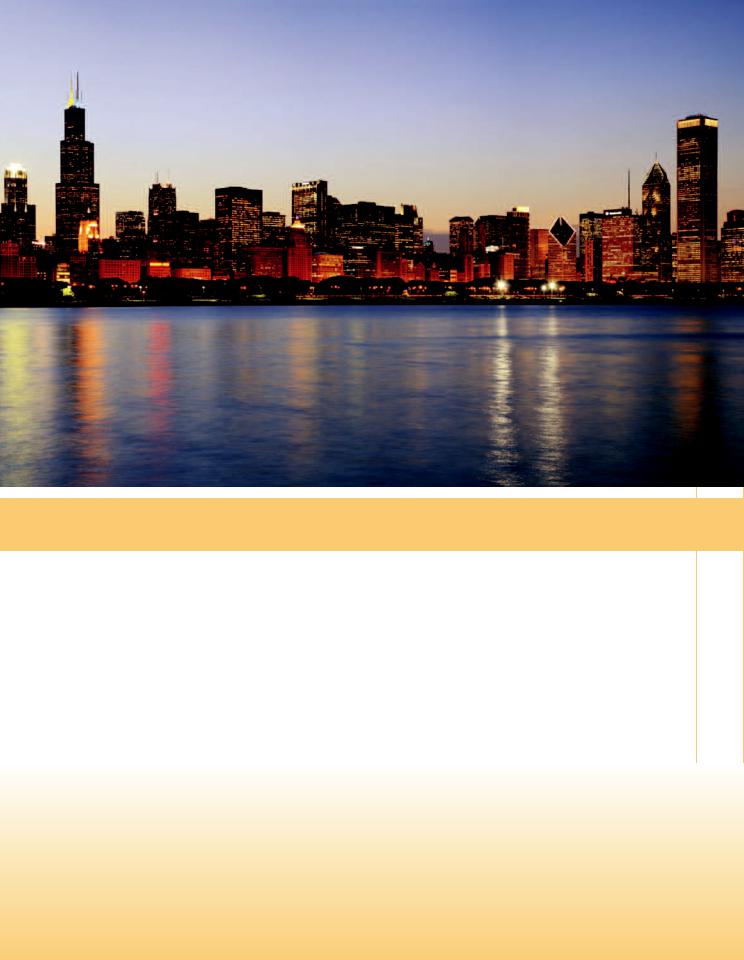
Chicago (above) was home to the world’s first skyscraper. In modern times, the city is filled with many tall, boxy office towers.
ThisÂabsorption helps heat the building. In summer the steel and glass reflect some of the sunlight. This reflection helps keep the building from getting too hot. Traditional skyscrapers are well suited to cities such as Chicago and New York. These cities have cold, windy winters and hot summers.
Traditional skyscrapers have many windows. But people who work and live in the skyscrapers usually can’t open the windows for a fresh breeze. Instead, they must rely on a skyscraper’s air-conditioning system to keep them cool. When it’s cold outside, people rely on the building’s heating system to keep them warm.
“The skyscraper offers the greatest possibilities for [using] precious resources.”
Mesiniaga Menara
31
—Ken Yeang, architect, 2000
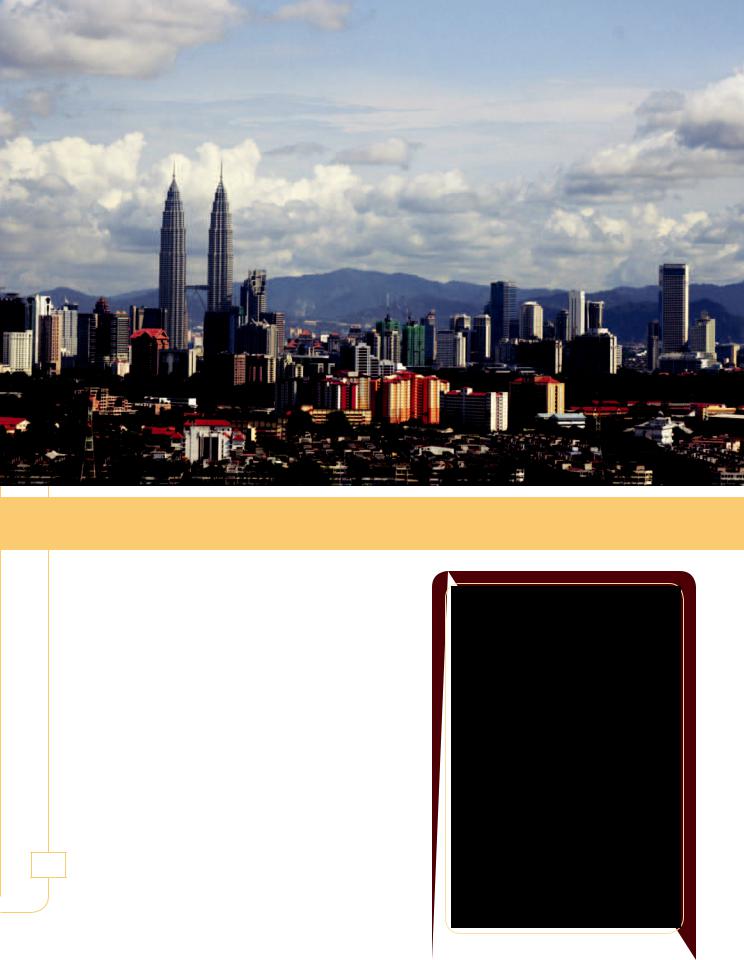
Seven Wonders of Green Building Technology
32
The Petronas Twin Towers rise high above the Kuala Lumpur skyline. Menara Mesiniaga is not nearly as tall, but it works in harmony with its tropical surroundings.
Tropical Skyscrapers
Many skyscrapers in Kuala Lumpur look like the skyscrapers in New York. They have the same boxy design. These big buildings are impressive. They tell the world that the people who work there are successful and powerful.
But in a tropical city, a traditional skyscraper does not make sense. Its windows don’t open to let in fresh tropical breezes. And the hot temperatures outside heat up the building’s concrete year-round. In Kuala Lumpur, traditional skyscrapers must be air-conditioned constantly.
Malaysia’s Skyline
Kuala Lumpur is Malaysia’s largest city. It has a tall skyline, with more than five hundred skyscrapers. Kuala Lumpur is home to the tallest twin buildings in the world.They are the PetronasTwinTowers.They
reach 1,483 feet (452 m) into the sky. Each building has eighty-eight floors.
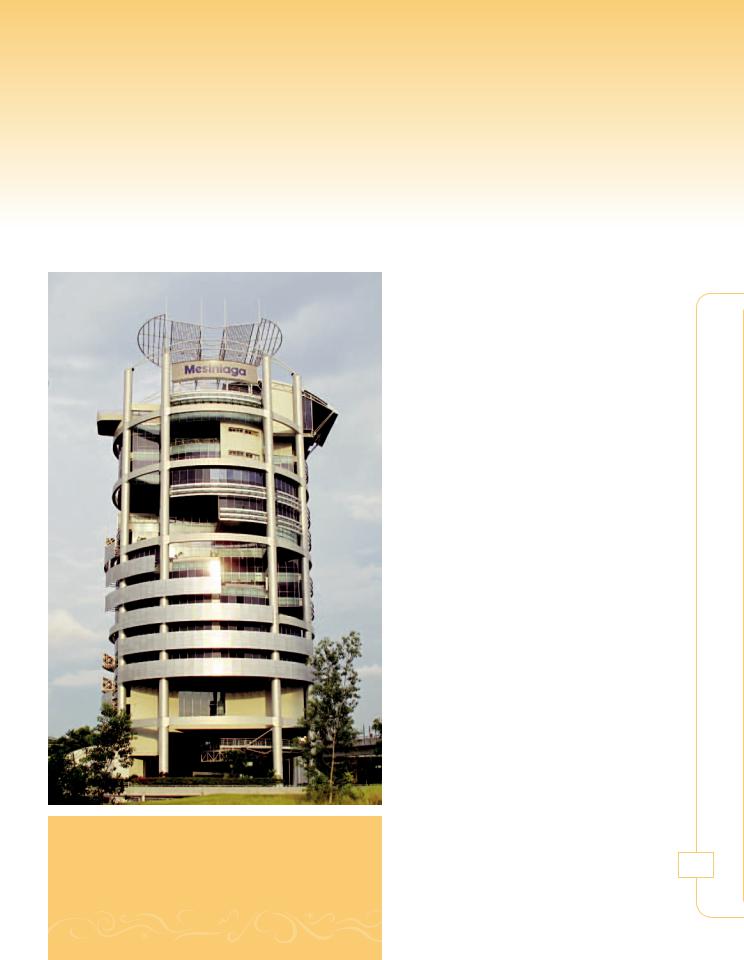
“Yeang designs his buildings for . . . hot, humid [regions]. . . . For such climates and places one must start from scratch and think things anew.”
—Leland M. Roth, Understanding Architecture, 2007
When designing Menara Mesiniaga, Ken Yeang wanted to take the climate into account. He wanted to use the tropical weather to heat and cool the skyscraper.
Menara Mesiniaga uses natural air-conditioning. Tropical breezes flow through its windows and open spaces.
Air and Light
Workers built Menara Mesiniaga between December 1990 and December 1992. The design is elaborate. The building looks nothing like the boxlike skyscrapers of most cities. It is a complex, winding cylinder made of steel and aluminum. The outside walls contain many balconies and open spaces. This design gives Menara Mesiniaga a unique look and feel.
The building has many windows, and they open and close. It also
has open spaces between floors. The windows and open spaces let natural breezes flow in and out of the building. People say that the tower can “breathe.” The tower’s many windows also allow sunshine to light the building during the
daytime. These simple design features save a lot of electricity. Workers can do their jobs and be comfortable without turning on lots of lights or airconditioning.
Mesiniaga Menara
33
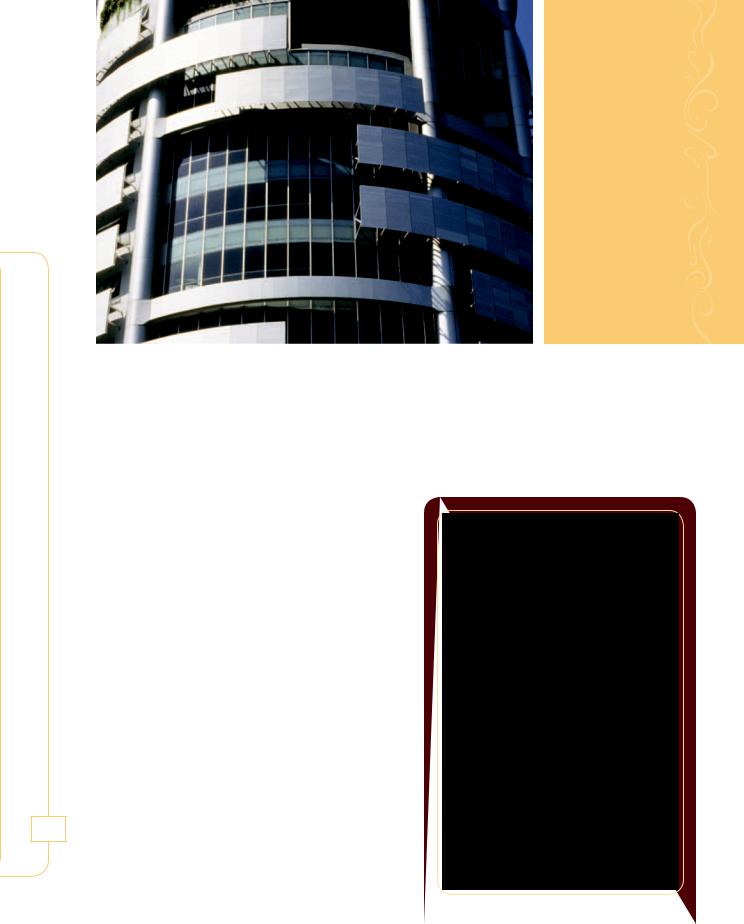
Menara Mesiniaga has special shutters that block the sun’s powerful rays.
Seven Wonders of Green Building Technology
34
Windows facing the east and west have louvers. Louvers are similar to shutters. The louvers open and close to let in and block out sunlight. When the sun rises in the east and sets in the west, the louvers shade the windows from direct sunlight. This shade helps cool the building. It reduces the need for air-conditioning. Even the stairways and restrooms let in fresh breezes and sunlight.
Green Gardens
Menara Mesiniaga has two large atriums, or inner courtyards. Native Malaysian plants grow inside the atriums. Some of the plants are tall trees and vines. They twist and wind up the atrium walls toward the roof and the balconies. A sunroof on top of the building provides the plants with light. The plants inside the tower provide natural shade. They help cool the building on hot days. The plants also improve air quality by releasing oxygen into the air. Clean air and fresh breezes are good for the health of people who work inside the tower.
By Any
Other
Name
“Menara Mesiniaga” means “MesiniagaTower” in the Malay language. Mesiniaga is the name of a Malaysian computer business. Mesiniaga partners with IBM,
a big U.S. computer company. Because of this connection, Menara Mesiniaga is often called the IBMTower.

Plants grow on balconies and in atriums (above). Inside, people take covered walkways (right) to their offices.
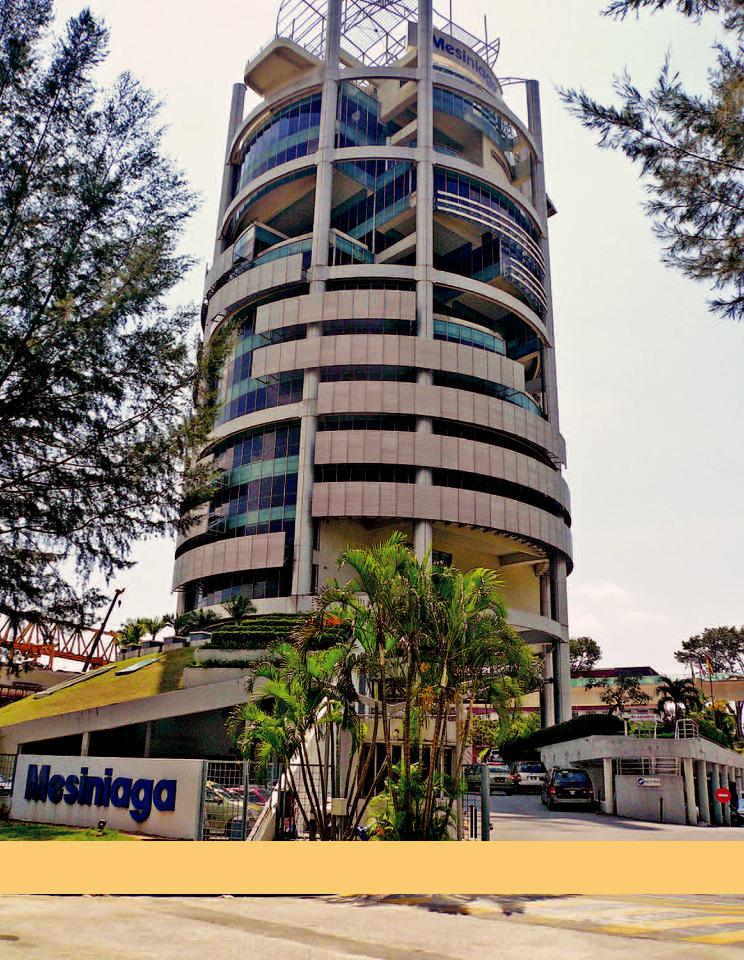
Menara Mesiniaga looks different than most other skyscrapers. And it provides a healthy and eco-friendly working environment.

Sick Building
Syndrome
People often joke that going to school or work makes them sick. For some people, this complaint is no joke. People who study or work in airtight buildings sometimes feel sick inside them.These people may have sick building syndrome (SBS).
Several things can cause SBS. Chemicals used to make carpeting and furniture can make people sick. Mold, pollen, or viruses can also make people sick.These tiny organisms can breed wherever water collects in a building, including in humidifiers, carpeting, and ceiling tiles. In buildings that do not have good ventilation, or airflow, people can breathe in the harmful chemicals and organisms.
A person with SBS might suffer from headaches, a scratchy throat, watery eyes, a cough, dizziness, or fatigue.
But the symptoms are often temporary. Once the person leaves the building, he or she usually feels well again.
People who design green buildings try to prevent SBS.They make sure the buildings have good ventilation. They include windows that open and close. Good ventilation means that people in a building are always getting a fresh supply of clean air.
Improving
the Health of the Planet
Green skyscrapers such as Menara Mesiniaga work with the natural environment instead of against it. They require less electricity to light and cool the building than traditional skyscrapers do. And people who work in the buildings feel better in the healthier environment.
Ken Yeang believes that architects can and should create skyscrapers that are healthy for the people who live and work in them. He also thinks buildings should make use of their environment. For Yeang and other Malaysians, building a healthy building was a smart idea.
Mesiniaga Menara
37
